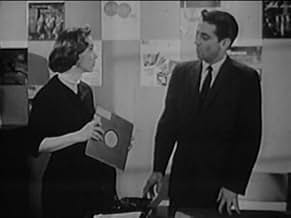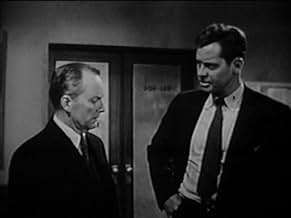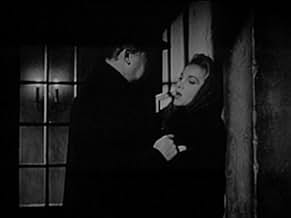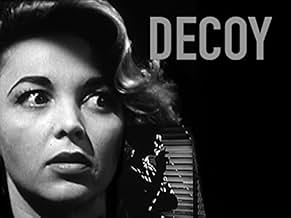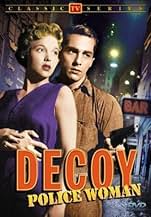New York City policewoman Casey Jones' assignment to fight crime often entails her going undercover in some of the seediest and most dangerous parts of the city.New York City policewoman Casey Jones' assignment to fight crime often entails her going undercover in some of the seediest and most dangerous parts of the city.New York City policewoman Casey Jones' assignment to fight crime often entails her going undercover in some of the seediest and most dangerous parts of the city.
Browse episodes
Featured reviews
Back in 1957, women were seen as homemakers, school teachers, nurses, sales clerks, and those roller skating waitresses at a "drive-in" diner. If they were a bit more down on their luck, they might be prostitutes, exotic dancers or bar waitresses on the seedier side of town.
But there was another role for particular women who could handle it, who were strong enough, brave enough and ready enough to step into it. And that's where this show tells its story.
At the beginning of each episode of "Decoy," there was a block of text that read as follows:
Presented as a tribute to the Bureau of Policewomen Police Department, City of New York.
This was the first time in television history that a woman was the lead character in a police-based action-adventure series, and the show was popular, though it wasn't available on a network, so it had a bit less reach. "Decoy" was telecast nationally, just not necessarily at the same time in every city and admittedly wasn't available everywhere, because of the limitations of syndication.
The decoy of "Decoy" is Detective Casey Jones, played by Beverly Garland, who goes undercover into the world of third shifters, nightclubs, and other sordid or common jobs that women might have to eke out a living at the time. She plays the roles in order to investigate cases of theft, drug trafficking, arson, racketeering, even murder.
As was the custom at this time, we never see or hear anything about the lead character's personal life, except what leaks out in her brief discussions with her colleagues, nearly all of whom are male. It's strictly police work and lots of it, with Casey needed to become proficient in all sorts of skills to find her way into the lives of the criminals and take them down. Conversely, Casey didn't have a partner, per se, and worked at night usually, so there really wasn't any time for blithe discussions about hobbies and relationships. That was important because it kept Casey a rock solid, no-nonsense character.
It was a tour-de-force role for Ms. Garland, who weekly got to do various things, singing, dancing, emoting, and fighting for her life as she was asked to step into the roles required of various jobs every week. She often had to play innocent, dumb, weak and vulnerable, though audiences knew that Casey was none of those things, which is another element that added quality to her portrayal.
New York played a part because the seamy underbelly of The City is always there and the need to stop crime when and where it happens is a regular element that, like NYC itself, constantly changed and grew. Current footage around town was included in each episode, which gave the series value as a Time Capsule for what NYC looked like at that moment, with the Times Square area being prominently featured, both in plots and in the program's opening titles.
"Decoy" wasn't canceled; it was ended because the producers ran out of cash to keep it going. This was well before a program like this could earn the kind of bucks that today's syndicated shows get. And it took nearly twenty years before Angie Dickinson took the titular role of "Police Woman" and a network finally picked up the concept of a woman undercover cop doing the job.
In a way, it's sad that more people don't know about this series and its groundbreaking star, who eventually played the part of Fred MacMurray's wife on the long running sitcom "My Three Sons" and played Amanda's mom on the comedy/drama "Scarecrow and Mrs. King," two roles that fell into the "typical" category for women to play on television.
The good thing is that "Decoy" is essentially in the Public Domain, so nearly all of the episodes are available to view on YouTube, and with a thirty minute run time (about 24 minutes without commercials), they are brief to watch and mostly pretty entertaining. Not a lot of lag time when you're setting up an episode, getting the baddies to fall into the trap and hauling them down to Central Booking.
This is presented as a tribute to a great, somewhat forgotten actress, Beverly Garland, who deserves to be remembered for her versatility, her balance and her convincing portrayal of a police officer at a time when only the guys were doing the tough stuff.
But there was another role for particular women who could handle it, who were strong enough, brave enough and ready enough to step into it. And that's where this show tells its story.
At the beginning of each episode of "Decoy," there was a block of text that read as follows:
Presented as a tribute to the Bureau of Policewomen Police Department, City of New York.
This was the first time in television history that a woman was the lead character in a police-based action-adventure series, and the show was popular, though it wasn't available on a network, so it had a bit less reach. "Decoy" was telecast nationally, just not necessarily at the same time in every city and admittedly wasn't available everywhere, because of the limitations of syndication.
The decoy of "Decoy" is Detective Casey Jones, played by Beverly Garland, who goes undercover into the world of third shifters, nightclubs, and other sordid or common jobs that women might have to eke out a living at the time. She plays the roles in order to investigate cases of theft, drug trafficking, arson, racketeering, even murder.
As was the custom at this time, we never see or hear anything about the lead character's personal life, except what leaks out in her brief discussions with her colleagues, nearly all of whom are male. It's strictly police work and lots of it, with Casey needed to become proficient in all sorts of skills to find her way into the lives of the criminals and take them down. Conversely, Casey didn't have a partner, per se, and worked at night usually, so there really wasn't any time for blithe discussions about hobbies and relationships. That was important because it kept Casey a rock solid, no-nonsense character.
It was a tour-de-force role for Ms. Garland, who weekly got to do various things, singing, dancing, emoting, and fighting for her life as she was asked to step into the roles required of various jobs every week. She often had to play innocent, dumb, weak and vulnerable, though audiences knew that Casey was none of those things, which is another element that added quality to her portrayal.
New York played a part because the seamy underbelly of The City is always there and the need to stop crime when and where it happens is a regular element that, like NYC itself, constantly changed and grew. Current footage around town was included in each episode, which gave the series value as a Time Capsule for what NYC looked like at that moment, with the Times Square area being prominently featured, both in plots and in the program's opening titles.
"Decoy" wasn't canceled; it was ended because the producers ran out of cash to keep it going. This was well before a program like this could earn the kind of bucks that today's syndicated shows get. And it took nearly twenty years before Angie Dickinson took the titular role of "Police Woman" and a network finally picked up the concept of a woman undercover cop doing the job.
In a way, it's sad that more people don't know about this series and its groundbreaking star, who eventually played the part of Fred MacMurray's wife on the long running sitcom "My Three Sons" and played Amanda's mom on the comedy/drama "Scarecrow and Mrs. King," two roles that fell into the "typical" category for women to play on television.
The good thing is that "Decoy" is essentially in the Public Domain, so nearly all of the episodes are available to view on YouTube, and with a thirty minute run time (about 24 minutes without commercials), they are brief to watch and mostly pretty entertaining. Not a lot of lag time when you're setting up an episode, getting the baddies to fall into the trap and hauling them down to Central Booking.
This is presented as a tribute to a great, somewhat forgotten actress, Beverly Garland, who deserves to be remembered for her versatility, her balance and her convincing portrayal of a police officer at a time when only the guys were doing the tough stuff.
Most lead characters on TV cop shows in the 1950s and 60s were guys. Decoy was a departure from the usual fare by casting Beverly Garland as Policewoman Casey Jones. Amazon Prime currently has all episodes available.
"Decoy," a title fitting perfectly with Casey's assignments, would have benefited with the more marketable name "Policewoman." Surprisingly the classictvhistory.wordpress blog only mentions Decoy once in an article about Brenner, another late-50s Manhattan-based crime show. It deserves a detailed analysis.
What I first noticed about Decoy is the performance by the great Beverly Garland and her sympathetic yet no-nonsense, duty-bound and calm characterization. There is no humor whatsoever in Decoy, not even fatalistic police humor or the sardonic closing line of a conversation that Jack Webb practically patented in Dragnet. In her narration, she accepts her job with a sense of pessimism about the worst qualities of human nature that she knows will continue to repeat. What real policemen and policewomen see and deal with everyday would break the average person.
Then there's the world Casey lives in, when police science technology was still fairly crude and a lack of knowledge by the TV writers about the physical reality of criminal acts, something that continues in today's TV and films. She relies on her intuition and her ability to influence criminals to accept her so she can find the evidence or get the confession that allows her to slap the cuffs on them. There's very little gun play and shootouts, no insane car chases or gun glorification that's filled TV screens for decades and there's not much physical violence, something that Angie Dickinson's Policewoman would make up for in the more permissive 1970s, adding sexual themes and an emphasis on Dickinson's sex appeal to the mix.
The black and white location shooting of New York City and outer boroughs, when the city was heading to a decline adds a huge downbeat, melancholy tone. The dirty streets, sense of decay and crumbling tenements that Naked City also captured (and Hawk did in color in the 60s) creates a moody, grim feel to Casey's thankless job. The threadbare, shabby studio sets, a standard in 50s TV, reinforces that atmosphere. The brief, opening theme music to Decoy is stock, used in several earlier movies, and creates a sense of impending doom that sets the pace.
Casey solves her cases with a sense of fatalism, knowing that solving a case doesn't close the book on the tragedy in the wake of a crime. Families are destroyed, reputations are tarnished.
Later on, Beverly Garland opened the Beverly Garland hotel in Studio City. I occasionally attended movie collectible shows at the hotel but never had the chance to meet her and get an autograph. Now called The Garland as of 2014, it was built by her second husband.
"Decoy," a title fitting perfectly with Casey's assignments, would have benefited with the more marketable name "Policewoman." Surprisingly the classictvhistory.wordpress blog only mentions Decoy once in an article about Brenner, another late-50s Manhattan-based crime show. It deserves a detailed analysis.
What I first noticed about Decoy is the performance by the great Beverly Garland and her sympathetic yet no-nonsense, duty-bound and calm characterization. There is no humor whatsoever in Decoy, not even fatalistic police humor or the sardonic closing line of a conversation that Jack Webb practically patented in Dragnet. In her narration, she accepts her job with a sense of pessimism about the worst qualities of human nature that she knows will continue to repeat. What real policemen and policewomen see and deal with everyday would break the average person.
Then there's the world Casey lives in, when police science technology was still fairly crude and a lack of knowledge by the TV writers about the physical reality of criminal acts, something that continues in today's TV and films. She relies on her intuition and her ability to influence criminals to accept her so she can find the evidence or get the confession that allows her to slap the cuffs on them. There's very little gun play and shootouts, no insane car chases or gun glorification that's filled TV screens for decades and there's not much physical violence, something that Angie Dickinson's Policewoman would make up for in the more permissive 1970s, adding sexual themes and an emphasis on Dickinson's sex appeal to the mix.
The black and white location shooting of New York City and outer boroughs, when the city was heading to a decline adds a huge downbeat, melancholy tone. The dirty streets, sense of decay and crumbling tenements that Naked City also captured (and Hawk did in color in the 60s) creates a moody, grim feel to Casey's thankless job. The threadbare, shabby studio sets, a standard in 50s TV, reinforces that atmosphere. The brief, opening theme music to Decoy is stock, used in several earlier movies, and creates a sense of impending doom that sets the pace.
Casey solves her cases with a sense of fatalism, knowing that solving a case doesn't close the book on the tragedy in the wake of a crime. Families are destroyed, reputations are tarnished.
Later on, Beverly Garland opened the Beverly Garland hotel in Studio City. I occasionally attended movie collectible shows at the hotel but never had the chance to meet her and get an autograph. Now called The Garland as of 2014, it was built by her second husband.
One would call "Decoy" for what it is... a female "Dragnet", with the beguiling Beverly Garland ("My Three Sons", "Scarecrow and Mrs. King") and the city of New York filling in for Jack Webb and sunny Los Angeles. But once you get caught in its premise, it's easy to overlook other aspects of the show. Such as the fact that Ms. Garland is required, in her role as undercover policewoman Patricia "Casey" Jones, to play a different role in each of the 39 episodes filmed. In one episode, she could play an exotic dancer in a carnival, in the next, she can play an addict, and so on and so on, all in the guise of a crime fighter. Whether Angie Dickinson, as Pepper Anderson - "Police Woman", took her cues from Beverly Garland is open to debate, but it's clear to say that Ms. Garland's Casey Jones is clearly a trailblazer for other lady lawmen to follow.
As for the other co-star, New York City... "Decoy" isn't the first series filmed on location in the Big Apple, nor was it the last, but it was certainly one of the most effective in terms of its film noir look and fully fleshed characters. This isn't "Naked City", but it's as close a similarity as you can get on a shoestring budget. And it does the city justice, as "Naked City" would do the next year. Check it out on DVD when you get the chance.
"Decoy" is a Pyramid Production in association with Official Films, Inc. with technical assistance from the Policewoman's Bureau, NYC Police Department. 39 episodes were filmed on location in 1957.
As for the other co-star, New York City... "Decoy" isn't the first series filmed on location in the Big Apple, nor was it the last, but it was certainly one of the most effective in terms of its film noir look and fully fleshed characters. This isn't "Naked City", but it's as close a similarity as you can get on a shoestring budget. And it does the city justice, as "Naked City" would do the next year. Check it out on DVD when you get the chance.
"Decoy" is a Pyramid Production in association with Official Films, Inc. with technical assistance from the Policewoman's Bureau, NYC Police Department. 39 episodes were filmed on location in 1957.
Yes, this is a wonderfully gritty, no-nonsense cop yarn. What struck me is: Where's the sexism? Where's the condescension? Where's the "Oh, ya gonna arrest me, Officer Sweetie Pie?" This was the Fifties, right? It's a cop show with a twist: a cop who gets emotional over what she sees and what she has to do. But Casey Jones never, and I mean never, lets it get in the way of her completely professional approach to her job. She works with male officers, and they are nothing if not equals, comrades in arms. And for those of you who know Beverly Garland only from the fluff of My Three Sons, have you got a surprise coming. Great entertainment all the way around. And for something a little snappier, try Front Page Detective.
Decoy's the first TV police drama to star a woman and casting couldn't have done better than Garland. She's strong and appealing but hardly glamorous, and really good at not over-playing her part though the tension is often there. As Casey Jones she goes undercover in downscale NYC to crack cases. The on-location filming in the city's seediest precincts lends a lot of color plus perspective to even the mildest episodes. Nevertheless, I'll bet the Chamber of Commerce was none to happy about grubby sites not often shown. Anyway, we get perspectives on the Statue of Liberty, crowded city streets, and soaring towers that seemingly entrap her as she walks along. All add color and period interest to the storylines. Of course some episodes are better than others but all offer abundant compensations. I haven't seen every episode, but let me recommend The Red Clown as particularly riveting. A look at the cast lists shows no stars but an abundance of familiar A-grade supporting players, e.g. Simon Oakland, Barbara Barrie. I guess ratings weren't strong enough for a second season (1958). Likely, 50's audiences weren't ready for a female lead in a traditionally male genre. Then again, to my knowledge, Decoy's never been re-run or put into syndication; so to say it's obscure is a mild understatement. Too bad, because the series was clearly ahead of its time, while its abundant human interest has no time limit.
In passing-- I caught up with the complete series in a DVD collection titled "Decoy" from Film Chest Media. I'd recommend the collection because of the detailed notes about locations and historical aspects of the productions that the enclosed booklet provides. For those like me who've never been to NYC, it's something of an interesting tour guide.
In passing-- I caught up with the complete series in a DVD collection titled "Decoy" from Film Chest Media. I'd recommend the collection because of the detailed notes about locations and historical aspects of the productions that the enclosed booklet provides. For those like me who've never been to NYC, it's something of an interesting tour guide.
Did you know
- TriviaThe first cop show with a female protagonist.
- Crazy creditsOpening credits include the dedication: "Presented as a tribute to the BUREAU OF POLICEWOMEN Police Department City of New York."
- How many seasons does Decoy have?Powered by Alexa
Details
- Runtime30 minutes
- Color
- Sound mix
- Aspect ratio
- 1.33 : 1
Contribute to this page
Suggest an edit or add missing content


